Some innovative mortgage data: RBA assistant governor
RBA Assistant Governor (Financial Markets) Christopher Kent speaks at Moody's Analytics Australia Conference 2017
I'd like to thank Moody's for the invitation to speak to you at this conference on innovation in banking and risk management. My discussion is relevant to both of these issues.
The Reserve Bank has always emphasised the value of using a wide range of data to better understand economic developments. One relatively new source of data for us is what we refer to as the Securitisation Dataset. Today, I'll briefly describe this dataset and then I want to tell you a few of the interesting things we are learning from it.[1]
The Bank collects data on asset-backed securities. Currently, the dataset covers about 280 ‘pools’ of securitised assets. We require these data to ensure that the securities are of sufficient quality to be eligible as collateral in our domestic market operations. The vast bulk of the assets underlying these securities are residential mortgages (other assets, such as commercial property mortgages and car loans, constitute only about 2 per cent of the pools). Some of these are ‘marketed securities’ that have been sold to external investors. There are also securities that banks have ‘self-securitised’.[2]
Self-securitisations are primarily used by participating banks for the Committed Liquidity Facility (CLF) in order to meet their regulatory requirements.[3] The size of the CLF across the banking system is currently $217 billion. Self-securitisations are also used to cover payment settlements that occur outside business hours via ‘open repo’ transactions with the RBA.
The Bank has required the securitisation data to be made available to permitted data users (such as those who intend to use the data for investment, professional or academic research). This has helped to enhance the transparency of the market. Much of that has been achieved by requiring data that is comparable across different pools of securities.
Another benefit of the Securitisation Dataset is that it provides a useful source of information to help us better understand developments in the market for housing loans. The dataset covers information on 1.6 million individual mortgages with a total value of around $400 billion. Currently, this accounts for about one-quarter of the total value of home loans outstanding in Australia.
Nature of the data
Let me make a few brief remarks about the nature of the data.
For each housing loan, we collect (de-identified) data on around 100 fields including:
- loan characteristics, such as balances, interest rates, loan type (e.g. principal-and-interest (P&I), interest-only), loan purpose (e.g. owner-occupier, investor) and arrears status;
- borrower characteristics, such as income and the type of employment (e.g. pay as you go (PAYG), self-employed);
- details on the collateral underpinning the mortgage, such as the type of property (e.g. house or apartment), its location (postcode) and its valuation.[4]
The dataset is updated each month with a lag of just one month. The frequency and timeliness of the data allow us to observe changes in interest rates, progress on repayments (i.e. the current loan balance) and the extent of any redraw or offset balances (just to name a few) without much delay.
I should note that, while the dataset covers a significant share of the market for housing loans, it may not be entirely representative across all its dimensions. In particular, the choice of assets in the collateral pool may be influenced by the way that credit ratings agencies assign ratings and by investor preferences. Also, in practice it may take quite a while until new loans enter a securitised pool. I'll mention one important example of this later.
Now let's look at some interesting things we have learnt from this dataset.
1. Interest Rates
In the years prior to 2015, banks would generally advertise only one standard variable reference rate for housing loans.[5] There was no distinction, at least in advertised rates, between investors and owner-occupiers, or between principal-and-interest and interest-only loans. That changed when the banks responded to requirements by the Australian Prudential Regulation Authority (APRA) to tighten lending standards, with a particular focus on investor loans. Then, earlier this year, APRA and the Australian Securities and Investments Commission (ASIC) further tightened lending standards: this time the focus was on interest-only lending. A key concern has been that interest-only loans are potentially more risky than principal-and-interest loans. This is because with a principal-and-interest loan the borrower is required to regularly pay down the loan and build up equity. Also, interest-only borrowers can face a marked step-up in their required repayments once they come off the interest-only period (after the first few years of the loan term).
Among other things, the banks have responded to these regulatory actions by increasing interest rates on investor and interest-only loans. There are now four different advertised reference rates, one for each of the key types of loans (Graph 1). While the data in Graph 1 provide a useful guide to interest rate developments, they only cover advertised or reference rates for variable loans applicable to the major banks. Actual rates paid on outstanding loans differ from these for a few reasons. Borrowers are typically offered discounts on reference rates, which can vary according to the characteristics of the borrower and the loan. Discounts offered may vary across institutions, reflecting factors such as funding costs and market segmentation. (For example, non-bank lenders typically compete for different borrowers than the major banks.) The level of the discounts has also varied over time. Furthermore, there are fixed-rate loans, for which rates depend on the vintage of the loan.
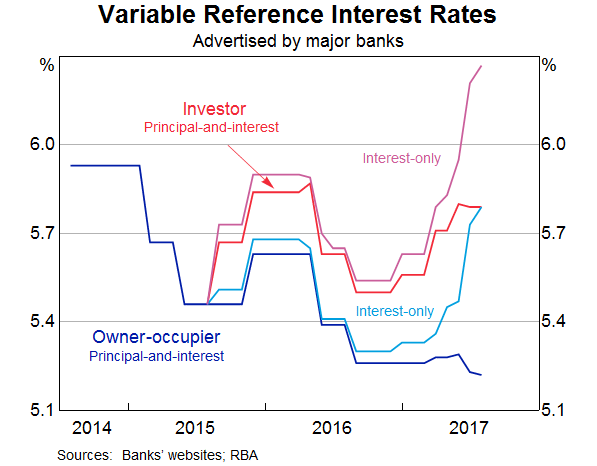
The Securitisation Dataset provides us with a timely and detailed source of information on the actual interest rates paid by households on their outstanding loans. Graph 2 shows rates paid on specific types of loans and by different types of borrowers.[6]
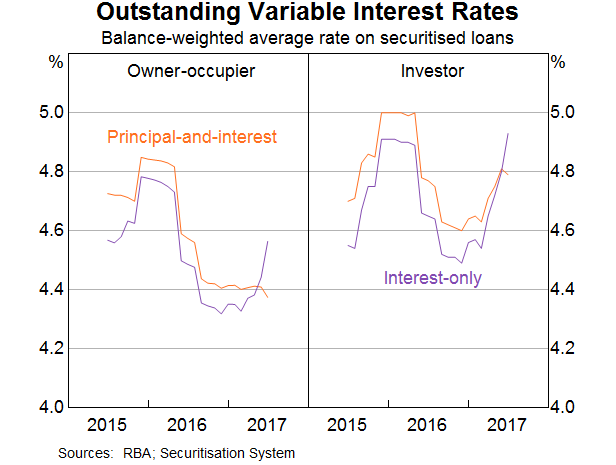
The first thing to note is that rates on owner-occupier loans and investor loans used to be similar, but investor loans became relatively more expensive from the latter part of 2015. Again, this followed regulatory measures to impose a ‘benchmark’ on the pace of growth of investor credit, which had picked up noticeably.
The second development I'd draw your attention to is the variation in housing loan interest rates over time. There were declines in 2016 following the reduction in the cash rate when the Reserve Bank eased monetary policy in May and then August. More recently, rates have increased for investor loans and interest-only loans, with a premium built into the latter as lenders have responded to the tightening in prudential guidance earlier this year. As part of that guidance, lenders will be required to limit the share of new mortgages that are interest-only to 30 per cent. Meanwhile, interest rates on principal-and-interest loans to owner-occupiers are little changed and remain at very low levels. Pulling this all together, the average interest rate paid on all outstanding loans has increased since late last year, but only by about 10 basis points.
A third and subtle point relates to the differences in the level of interest rates actually paid on different loan products (Graph 2) when compared with reference rates (Graph 1). The reference rates suggest that any given borrower would expect to pay a higher rate on an interest-only loan than on a principal-and-interest loan. That makes sense for two reasons. First, because the principal is paid down in the case of principal-and-interest loans, those loans are likely to be less risky for the banks; other things equal, you would expect them to attract a lower interest rate. Second, the banks have added a premium to interest-only loans of late to encourage customers to take on principal-and-interest loans and constrain the growth of interest-only lending.
But Graph 2 (based on securitised loans) suggests that, up until most recently, actual rates paid on interest-only loans have been lower than those on principal-and-interest loans. This doesn't necessarily imply a mispricing of risk. Rather, it appears to reflect differences in the nature of loans and borrowers across the two types of loan products. In particular, borrowers with an interest-only loan tend to have larger loan balances (of around $85 000–100 000) and higher incomes (of about $30 000–40 000 per annum).[7]
We can control for some of these differences between loan characteristics (such as loan size, loan-to-valuation ratio (LVR) and documentation type). When we do that, we find that rates have been much more similar across the two loan types in the past; although, a wedge has opened up more recently as we'd expect (Graph 3).
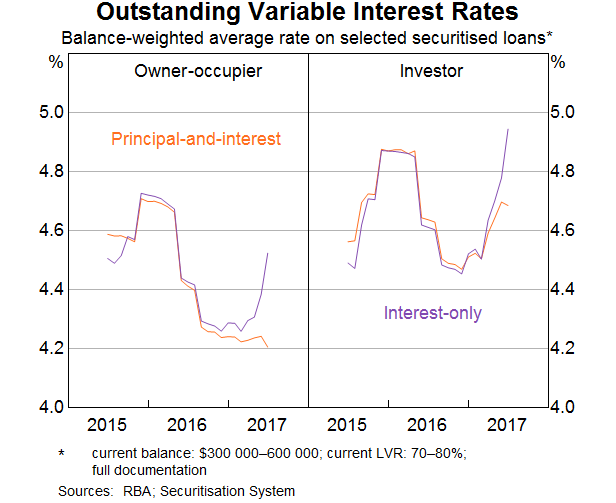
This highlights the value of examining loan-level data. We find that interest rates are lower for borrowers that are likely to pose less risk (as indicated, for example, by lower loan-to-value ratios and full documentation). Borrowers with larger loans – who typically have higher income levels – also tend to attract lower interest rates. In relation to loan size, this suggests that borrowers with larger loans may have somewhat greater bargaining power.
2. Loan-to-Valuation Ratios and Offset Balances
The Securitisation Dataset provides us with a measure of the LVR, based on the current loan balance.[8] We refer to this here as the ‘current LVR’. This is one indicator of the riskiness of a loan. Other things equal, higher LVRs tend to be associated with a greater risk of default (and greater loss for the lender in the case of default).[9]
Graph 4 shows current LVRs for owner-occupiers and investor loans, split into interest-only and principal-and-interest loans. I should emphasise again that the Securitisation Dataset may not be entirely representative of the set of all mortgages, particularly when it comes to LVRs. That is because high LVR loans may be less likely to be added to a pool of securitised assets in order to ensure that the securitisation achieves a sufficiently high credit rating.[10]
With that caveat in mind, we see that there is a large share of both owner-occupier and investor loans with current LVRs between 75 and 80 per cent. That is consistent with banks limiting the share of loans with LVRs (at origination) above 80 per cent. Also, borrowers have an incentive to avoid the cost of mortgage insurance, which is typically required for loans with LVRs (at origination) above 80 per cent.
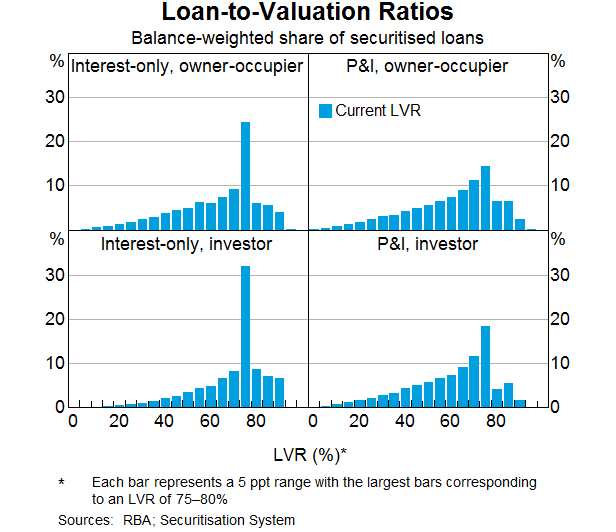
Comparing investor loans with owner-occupier loans, we can see that investors have a larger share of outstanding loans with current LVRs of 75 per cent or higher.[11] That's most obvious in the case of interest-only loans, but is also true for principal-and-interest loans. This reflects the investor's financial incentive to maximise the amount of funds borrowed (without breaching the banks' threshold above which they require lenders mortgage insurance). That can be more easily achieved with an interest-only loan. And, even in the case of principal-and-interest loans, investors don't have the same incentives as owner-occupiers to get ahead of their scheduled repayments.
But what I've just shown doesn't account for offset accounts. These have grown rapidly over recent years and are now an important feature of the Australian mortgage market (Graph 5). Funds held in these accounts are ‘offset’ against the loan balance, reducing the interest payable on the loan. In that way they are similar to a principal repayment. But, unlike the scheduled principal repayment, offset (and redraw) balances can be moved in and out freely by the borrower.
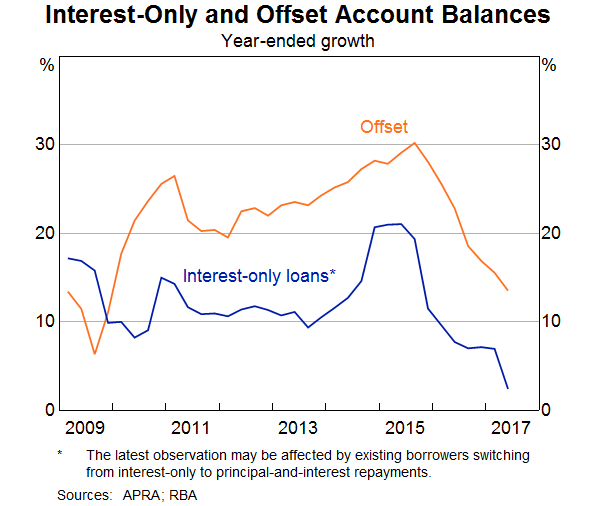
Part of the strong growth in offset balances up to 2015 appears to have been related to the rise in the share of interest-only loans, with the two being offered as a package. Interestingly, we saw a significant slowing in growth in offset balances around the same time as growth in interest-only housing loans started to decline.
Graph 6 highlights how the distribution of current LVRs is altered if we deduct funds held in offset accounts from the balance owing. This suggests that for owner-occupier loans, interest-only borrowers are behaving somewhat like those with principal-and-interest loans. That is, many of those borrowers have built up significant balances in offset accounts. If needed in times of financial stress – such as a period of unemployment – borrowers could use those balances to service their mortgages.
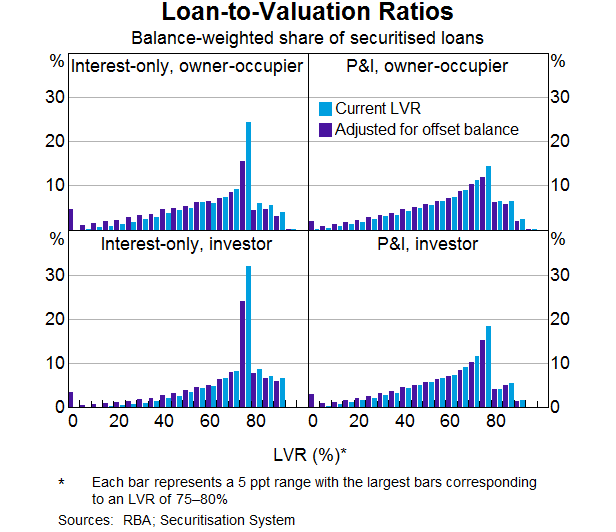
However, I would caution against any suggestion that this similarity regarding the build-up of financial buffers means that the tightening of lending standards for interest-only loans was not warranted – far from it. What matters when it comes to financial stability is not what the average borrowers are doing, but what the more marginal borrowers are doing. There are two important points to make on this issue.
First, for investor loans, even after accounting for offset balances, there is still a noticeable share of loans with current LVRs of between 75 and 80 per cent. And for both investor and owner-occupier loans, adjusting for offset balances leads to only a small change in the share of loans with current LVRs greater than 80 per cent. This suggests that borrowers with high current LVRs have limited repayment buffers.
The second point is that more marginal borrowers are now more likely to take on a principal-and-interest loan than in the past. One reason is that there is a premium on the interest rates charged on an interest-only loan (for any given borrower, compared with an owner-occupier loan). Another reason is that banks, at APRA's direction, have also tightened their lending standards for interest-only loans, most notably by reducing the share of new interest-only loans with high LVRs at origination.[12]
3. Arrears by region
Banks' non-performing housing loans have increased a little over recent years (Graph 7). However, at around ¾ of one per cent as a share of all housing loans, non-performing loans remain low and below the levels reached following the global financial crisis.
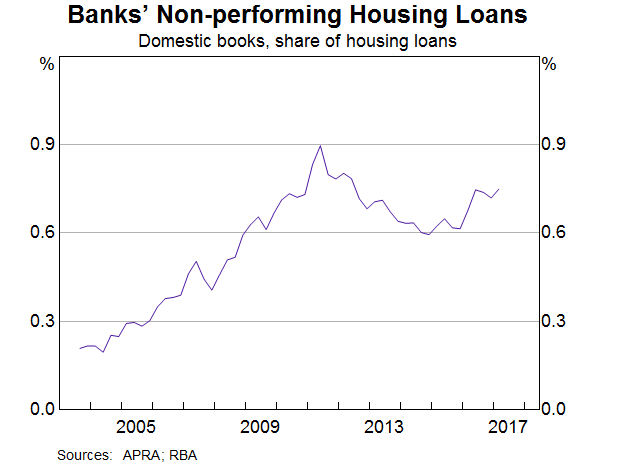
Using the Securitisation Dataset we can assess how loans are performing across different parts of the country by examining arrears rates. Like non-performing loans, the arrears rates have increased a little but remain low.[13] Arrears have risen more in regions experiencing weak economic conditions over recent years. In particular, there has been a more noticeable pick-up in arrears rates in Western Australia, South Australia and Queensland since late 2015 (Graph 8).
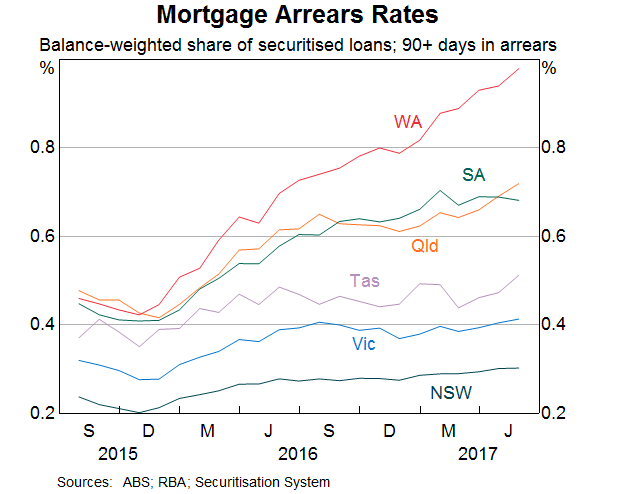
The Securitisation Dataset allows us to drill down even further to examine some relationships between arears and other factors. A key factor contributing to a borrower entering into arrears is a reduction in income, most obviously via a period of unemployment. We find that there is a positive relationship between arrears rates and the unemployment rate across regions (Graph 9).[14] However, the relationship is not especially strong, which suggests that other factors are at play. For example, arrears rates are higher in mining-exposed regions, which have generally experienced a sharp fall in demand following the end of the mining investment boom. One indicator of that has been the pronounced fall in the demand for housing in those parts of the country as indicated by a decline in housing prices (Graph 10).
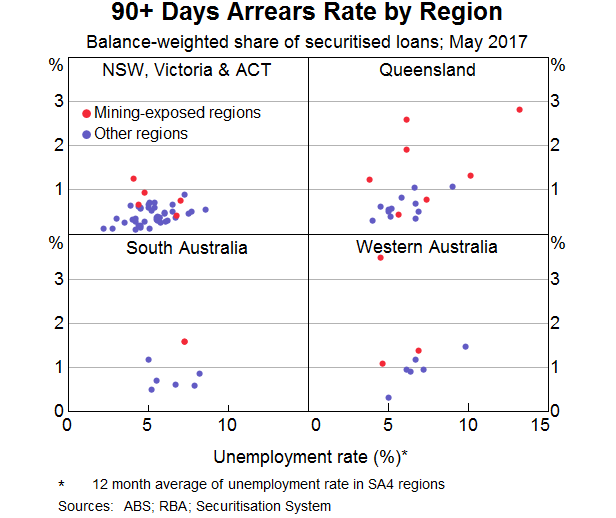
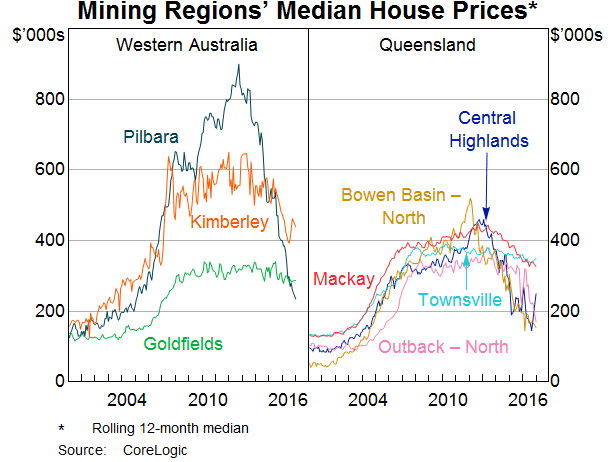
Conclusion
The Securitisation Dataset plays a crucial role in allowing the Reserve Bank to accept asset-backed securities as collateral in our domestic market operations. The development of this database and its availability to investors has also helped to enhance the transparency of the securitisation market.
A useful additional benefit of this database is that it provides us with a range of timely insights into the market for housing loans. I've discussed how things like actual interest rates paid, loan balances and arrears vary over time and across different types of mortgages and borrowers. Although variable interest rates for investor loans and interest-only loans have risen noticeably over recent months, the average interest rate paid on all outstanding loans has increased by only about 10 basis points since late last year. Also, many borrowers on interest-only loans have built up sizeable offset balances. But even after taking those into account, it appears that current loan-to-valuation ratios still tend to be larger than in the case of principal-and-interest loans. Finally, while mortgage arrears rates have increased slightly over recent years, they have increased more noticeably in regions exposed to the downturn in commodity prices and mining investment.
Endnotes
I thank Michael Tran and Michelle Bergmann for invaluable assistance in preparing these remarks.[*]
For more detail, see Aylmer C (2016), ‘Towards a More Transparent Securitisation Market’, Address to Australian Securitisation Conference, Sydney, 22 November.[1]
I use the term banks here to refer to all authorised deposit-taking institutions (ADIs), namely banks, building societies and credit unions.[2]
The RBA provides a Committed Liquidity Facility (CLF) to participating ADIs required by APRA to maintain a liquidity coverage ratio (LCR) at or above 100 per cent.[3]
For more details, see reporting templates on the Securitisations Industry Forum website. The valuation is typically from the time of origination.[4]
An exception was a period during the 1990s, when banks advertised distinct rates for owner-occupier and investor loans.[5]
Modernised reporting forms that are collected by APRA on behalf of the RBA and the Australian Bureau of Statistics will significantly improve the aggregate and institution-level data that are currently collected from ADIs and registered financial corporations (RFCs). While the new data will have less granularity than the Securitisation Dataset, they will have much greater coverage.[6]
The figure for income is the average of all borrowers for each loan. That is, a given loan may be in the name of more than one borrower; on average, there are 1.7 borrowers per loan.[7]
The balance of a loan is reduced via scheduled repayments of the principal and by any repayments ahead of schedule. The latter may be accessible through a redraw facility.[8]
Read, Stewart and La Cava (2014), ‘Mortgage-related Financial Difficulties: Evidence from Australian Micro-level Data’, RBA Research Discussion Paper No 2014-13.[9]
Some analysis we have conducted on the representativeness of the Securitisation Dataset suggests that it has fewer high LVR loans than the broader population of loans. There is also a tendency to include loans in securitisation pools only after they have aged somewhat (i.e. become more ‘seasoned’).[10]
The share of new investor loans with very high LVRs (above 90 per cent) at the time of origination has been declining for a few years and is below that for owner-occupier loans (Reserve Bank of Australia (2017), Financial Stability Review, April). This feature is not apparent in the data I've shown here, which is based on the current LVR for the stock of outstanding securitised loans, including those that are well advanced in age.[11]
APRA have instructed lenders to implement stricter underwriting standards for interest-only loans with LVRs greater than 80 per cent (see:
The 90+ days arrears rate refers to the share of loans that have been behind the required payment schedule or missed payments for 90 days or more but not yet foreclosed.[13]
These regions are defined in terms of the ABS's Statistical Areas Level 4 (SA4s), which are geographic boundaries defined for the Labour Force Survey. The boundaries for most SA4s cover at least 100 000 persons. The Securitisation Dataset identifies loans according to the location of the mortgaged property.
Click here to go to the RBA website.
